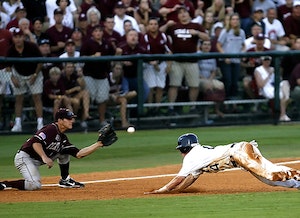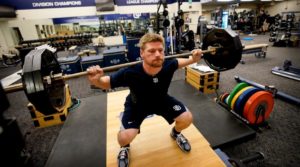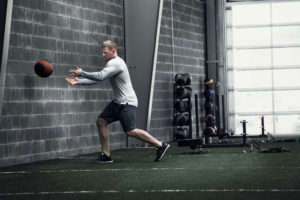How To Hit Homeruns
Every baseball player wants to learn how to hit homeruns. Power is the name of the game in baseball. Josh Donaldson famously said, “They don’t pay you for ground balls. They pay you for doubles and they pay you for homers.” Not to say that table setters aren’t valuable in baseball, they are, but it is not hard to argue that power is the most valued commodity in baseball. This article is a no BS approach that every baseball player needs to have if he wants to perform at his highest level and learn how to hit homeruns. We will discuss how physical size, joint mobility, strength & conditioning, nutrition and biomechanics work together to help hit harder and farther.
How To Hit Homeruns - Physical Size

Let’s begin with the understanding that players of greater physical size tend to perform better offensively. In a study called, Physical Size Associations to Offensive Performance Among Major League Leaders by Ryan Crotin found,
“Undeniably, Major League leaders transformed body mass-to- height proportions from 1980 onward, for which a rise in both physical size and offensive performance was concurrently seen among baseball’s most talented hitters and that body mass index positively associated with statistical performance over the 60-year analysis." (1)
Height and bodyweight are significantly correlated to offensive performance. Larger athletes lift, push and punch harder than smaller athletes, and this led to the establishment of weight classes for weight lifting, wrestling, and boxing. Larger athletes also swing harder and hit farther. Don’t believe me? Take a look at the leaders in exit velocity and home runs. Chances are you will see Giancarlo Stanton 6’ 6” 245 LBS and Aaron Judge 6’ 7” 282 LBS near the top of those lists every year. This is not meant to discourage you, it is to enlighten you that oftentimes a huge limiting factor in learning how to hit home runs is you need to get bigger through strength & conditioning and nutrition.
How To Hit Homeruns - Strength & Conditioning/Sports Nutrition

The discussion of physical size naturally leads us to the only way we can improve our physical size, strength & conditioning combined with nutrition. In Ryan Crotin's study, he goes on to say,
"Advances in hypertrophic stimuli, such as improved strength and conditioning practices among baseball populations (youth, high school, and collegiate), the emergence of sports nutrition, and global advances in nutrition may have facilitated the availability of larger players for professional drafts. Therefore, throughout the modern era of baseball, athletes of greater mass relative height seem to have greater advantages at the professional level." (1)
"Our results showed physical size (Body Mass Index) to positively influence Major League offensive statistics. Over the 60-year period, greater body weight-to-height proportions owed to improved competitive performance, which suggests a greater emphasis on hypertrophic stimuli in training and nutrition, as well as selection of larger professional baseball prospects." (1)
"Strength and conditioning coaches are important personnel to help maximize biologic factors through improved quality of hypertrophic stimuli (strength training and sports nutrition consumption) without the use of illicit performance enhancing drugs."(1)
Basically, the improvements and advances in strength & conditioning and sports nutrition have paved the way for bigger, faster, stronger athletes to enter into the professional levels of the game. If you are serious about learning how to hit homeruns, this section is the meat & potatoes of getting on that path. Your strength & conditioning needs to consist of heavy load training, olympic lift variations, medicine ball training, plyometrics and anaerobic conditioning. Your nutrition needs to support your training with the correct amount of calories, macronutrients and foods to build muscle, recover faster and perform at your highest level. If you need a programs to do that, look no further than the 5 Tool Prospect Manual and the Topvelocity Nutrition Manual. These year round training and nutrition manuals will provide you with the best training and information sports science has to offer. They consistently pump out athletes who can run faster, hit farther and throw harder.
https://www.instagram.com/p/Bmjy8XOjaAp/?taken-by=stevenguadagni
How To Hit Homeruns - Biomechanics/Joint Mobility
Next, you need to understand how your body produces force through the kinetic chain. A study called, The Biomechanics Of The Baseball Swing by David Fortenbaugh does a good job of describing how the kinetic chain transfers energy from the ground up to produce elite bat velocity and power.
"Energy is created by the batter through his utilization of the kinetic chain (Race, 1961; DeRenne, 1993). Linear and angular momentum are transferred from the ground up through the lower limbs, trunk, and upper limbs (i.e. the chain’s “links”) of the body. Each proximal segment passes its momentum to the connecting distal segment (e.g. upper arm to forearm to hand). To increase the resultant momentum, the muscles of the proximal segment provide an additional unique momentum before passing it to the next segment. In batting, the bat is gripped firmly at the hands, and the bat, in essence, becomes the final link of the kinetic chain. While the ultimate goal remains to maximize the linear and angular bat velocity, the kinetic chain theory clearly shows that each segment must do its part to contribute to the resultant bat velocity" (2)

In order to train yourself to enhance the kinetic chain, you need to use sport specific drills and exercises in your training that focus on utilizing the kinetic chain. Ballistic exercises like medicine balltraining and olympic lift variations are amazing for optimizing your kinetic chain and building power through it.
"Because the baseball/softball swing is a sequential, rotational kinetic link movement that incorporates the entire body from the legs, trunk, and shoulders to the arms, one should mimic the swing with sport-specific exercises. To do this, one should place additional resis- tance on the bat itself or throw medicine balls explosively to produce greater increases in bat swing velocity." (4)
"Programs that are directed toward multi-joint compound movements have revealed significant increases in swing velocity (Szymanski et al., 2007). One source noticed that compound lower body exercises, such as squat variations, lunge variations, and power clean variations, tend to result in the most significant improvements." (3)
How To Hit Homeruns - 2X Velocity Camp
To get an understanding of how you are producing force through your kinetic chain, you need a coach to analyze your swing and do a full assessment of your joint mobility. The reason you need a mobility evaluation is that if you have restrictions in your body it will keep you from optimally transferring force through your kinetic chain. I highly recommend coming down to one of our 2X Velocity Camp's so we can do a full evaluation of your biomechanics (sprint, swing and throw), joint mobility, nutrition, and athleticism.
https://www.instagram.com/p/BmzUXKBDvL1/?taken-by=stevenguadagni
We will find out exactly where you need to improve and take the guesswork out of enhancing your performance. You can find out more information on what is involved with a 2X camp here. We have long-term housing and training options as well. In the meantime, feel free to DM me video on my Instagram @stevenguadagni and I will give you a quick analysis for free. Thanks for reading guys and I hope this article brings you value and success!
References
- Crotin, Ryan L., et al. "Physical size associations to offensive performance among major league leaders." The Journal of Strength & Conditioning Research 28.9 (2014): 2391-2396.
- Fortenbaugh, David. "The biomechanics of the baseball swing." (2011).
- Miller, Ryan M. The Relationship of Maximal Leg Power and Swing Velocity in Collegiate Athletes. Diss. 2017.
- Szymanski, David J., Coop DeRenne, and Frank J. Spaniol. "Contributing factors for increased bat swing velocity." The Journal of Strength & Conditioning Research 23.4 (2009): 1338-1352.



